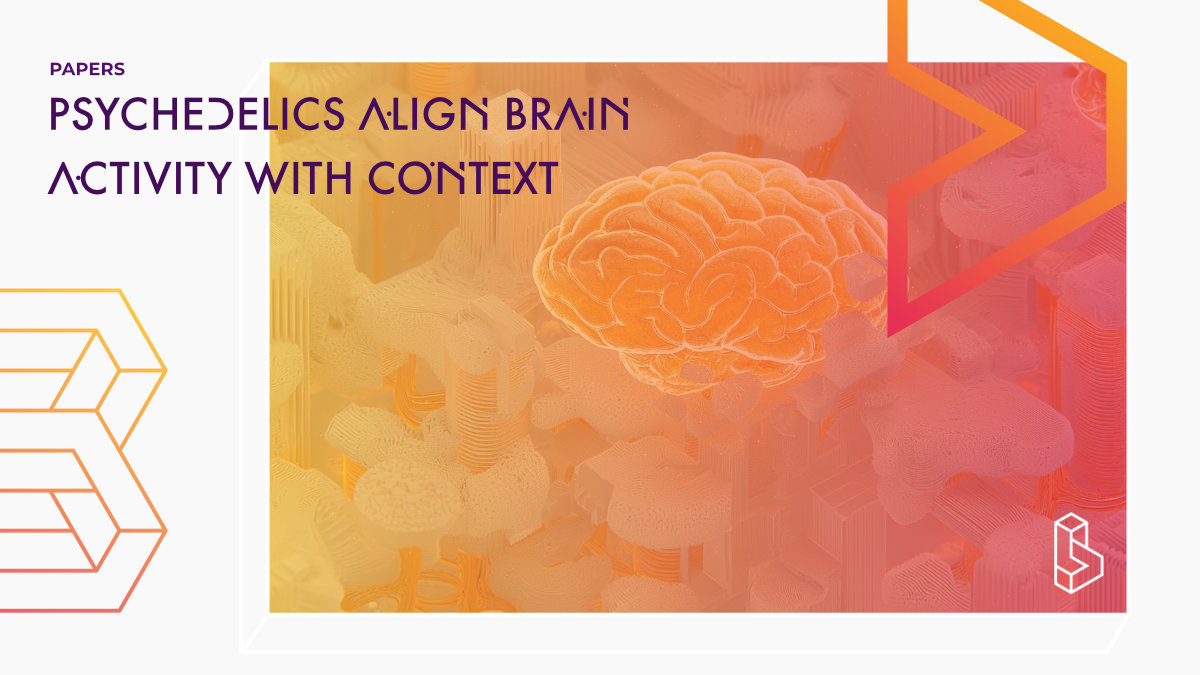This pre-print neuroimaging study (n=62) investigates how psilocybin (19mg) reorganises brain connectivity in different contexts using fMRI and EEG. Participants were scanned before and after ingestion during rest and naturalistic stimuli (meditation, music, and visual). Under psilocybin, brain activity in eyes-closed states became more similar to eyes-open states, with increased connectivity in associative regions and decreased connectivity in sensory areas. The findings suggest that psilocybin induces a state of “embeddedness,” reducing distinctions between self and environment, which may underlie both its subjective and therapeutic effects.
Abstract of Psychedelics Align Brain Activity with Context
“Psychedelics can profoundly alter consciousness by reorganising brain connectivity; however, their effects are context-sensitive. To understand how this reorganisation depends on the context, we collected and comprehensively analysed the largest psychedelic neuroimaging dataset to date. Sixty-two adults were scanned with functional MRI and EEG during rest and naturalistic stimuli (meditation, music, and visual), before and after ingesting 19 mg of psilocybin. Half of the participants ranked the experience among the five most meaningful of their lives. Under psilocybin, functional MRI and EEG signals recorded during eyes-closed conditions became similar to those recorded during an eyes-open condition. This change manifested as an increase in global functional connectivity in associative regions and a decrease in sensory areas. We used machine learning to directly link the subjective effects of psychedelics to neural activity patterns characterised by low-dimensional embeddings. We show that psilocybin reorganised these low-dimensional trajectories into cohesive patterns of brain activity that were structured by context and quality of subjective experience, with stronger self- and boundary-related effects–which were linked to day-after mindset changes—leading to more structured and distinct neural representations. This reorganisation induces a state of ’embeddedness’ that arises when brain networks that usually segregate internal and external processing coherently integrate, aligning neural dynamics with context. This state corresponded to profound transformations of perception and self-boundaries, reducing the distinction between self and environment. Embeddedness serves as a bridging framework for understanding both the subjective and therapeutic effects of psychedelics. These findings provide a new account of the large-scale neurocognitive effects of psychedelics and demonstrate the utility of using machine learning methods in assessing state- and context-dependent neural dynamics and their association with psychological outcomes.“
Authors: Devon Stoliker, Leonardo Novelli, Moein Khajehnejad, Mana Biabani, Tamrin Barta, Matthew D. Greaves, Martin Williams, Sidhant Chopra, Olivier Bazin, Otto Simonsson, Richard Chambers, Frederick Barrett, Gustavo Deco, Anil Seth, Katrin H. Preller, Robin L. Carhart-Harris, Suresh Sundram, Gary F. Egan & Adeel Razi
Summary of Psychedelics Align Brain Activity with Context
Psychedelics are known to induce profound alterations in consciousness, with many users describing these experiences as among the most meaningful of their lives. Beyond their subjective effects, these substances have shown promise in treating mental health conditions such as depression, anxiety, and addiction. The therapeutic potential of psychedelics is believed to stem from their ability to disrupt rigid patterns of brain activity and facilitate new neural connections. However, the mechanisms underlying these effects, particularly the role of context, remain unclear.
The brain constructs perception and a sense of self by integrating external sensory input with internal cognitive processes. This interaction is facilitated by complex structural and functional connectivity patterns across different brain regions. Psychedelics, including psilocybin, act as agonists at the serotonin 5-HT2A receptor, leading to widespread changes in brain connectivity. Previous research has shown that psychedelics alter the function of the default mode network (DMN), a key brain system involved in self-referential thoughts, memory, and emotional regulation. These changes are thought to underlie the subjective dissolution of the ego and the profound sense of interconnectedness that many users report.
Despite mounting evidence that psychedelics induce large-scale reorganisation of brain networks, most existing studies rely on small sample sizes and limited experimental conditions. To address these limitations, Stoliker and colleagues conducted the largest psychedelic neuroimaging study to date, combining functional MRI (fMRI) and electroencephalography (EEG) to assess how psilocybin affects brain connectivity across different contexts. The study aimed to explore how psychedelics shape brain activity in response to resting states, meditation, music, and visual stimuli, and to determine how these effects relate to subjective experiences.
Methods
Participants
Find this paper
Psychedelics Align Brain Activity with Context
https://doi.org/10.1101/2025.03.09.642197
Open Access | Google Scholar | Backup | 🕊
Cite this paper (APA)
Stoliker, D., Novelli, L., Khajehnejad, M., Biabani, M., Barta, T., Greaves, M. D., ... & Razi, A. (2025). Psychedelics Align Brain Activity with Context. bioRxiv, 2025-03.
Study details
Compounds studied
Psilocybin
Topics studied
Neuroscience
Music
Healthy Subjects
Study characteristics
Original
Open-Label
Within-Subject
Bio/Neuro
Participants
62
Humans
Linked Clinical Trial
Investigating the impact of of Psilocybin and guided meditation on brain connectivity in healthy adultsThis Phase I trial (n=60) aims to investigate the impact of psilocybin (19mg) and guided meditation on brain connectivity (fMRI & EEG) in healthy adults.

